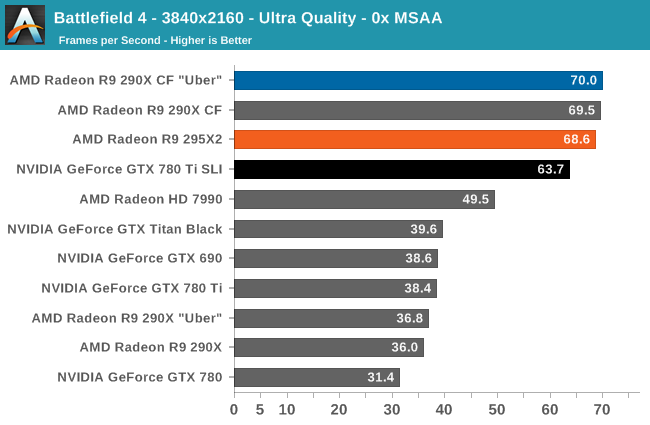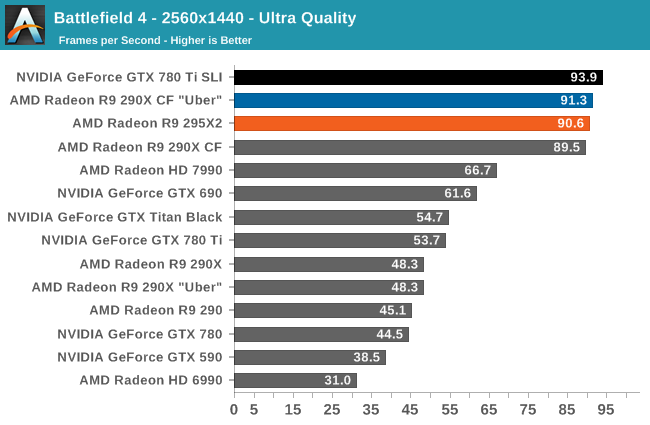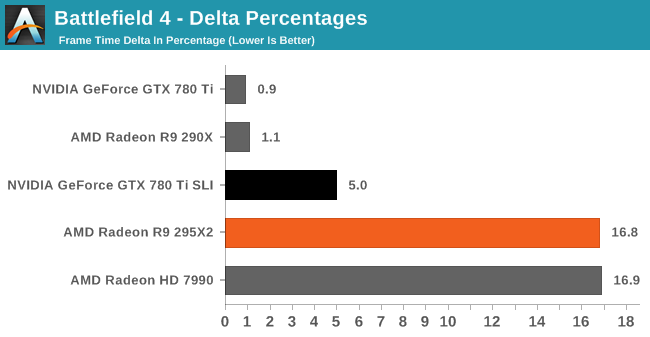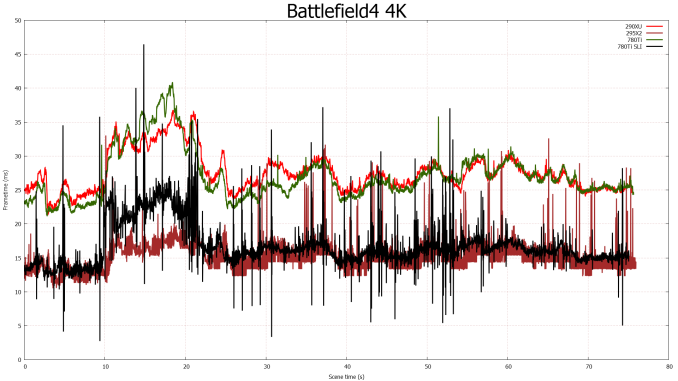The AMD Radeon R9 295X2 Review
by Ryan Smith on April 8, 2014 8:00 AM EST- Posted in
- GPUs
- AMD
- Radeon
- Radeon 200
Battlefield 4
Our current major multiplayer action game of our benchmark suite is Battlefield 4, DICE’s 2013 multiplayer military shooter. After a rocky start, Battlefield 4 has finally reached a point where it’s stable enough for benchmark use, giving us the ability to profile one of the most popular and strenuous shooters out there. As these benchmarks are from single player mode, based on our experiences our rule of thumb here is that multiplayer framerates will dip to half our single player framerates, which means a card needs to be able to average at least 60fps if it’s to be able to hold up in multiplayer.



As is the case in a few of our other games, whether it’s AMD who’s winning or NVIDIA who’s winning depends on the resolution. At 2160p with Ultra settings (and no MSAA) it’s AMD on top, with the 295X2 capable of delivering 68fps. This is safely past the 60fps threshold needed to ensure that minimum framerates don’t drop below 30fps in multiplayer. Otherwise at 1440p the NVIDIA GTX 780 Ti SLI setup pulls ahead, however the 295X2 is right on its tail.
In the meantime this game is also a good example of just how much faster than the 7990 the 295X2 is, despite the fact that both products are based on high-end (for their time) 28nm GPUs. The 295X2 ends up being over 40% faster at both 2160p and 1440p, showing just how far AMD has come in single card dual-GPU performance in the last year.


Shifting to our delta percentage benchmarks, we once more find that the 295X2 has no problem staying within the 20% threshold needed for smooth frame pacing. Though overall NVIDIA does hold an edge, especially at 1440p.












131 Comments
View All Comments
ruggia - Tuesday, April 8, 2014 - link
I'm looking at results from pcper and toms too and I see nothing "broken". In most cases variances are better than 780 sli or low enough to not be an issuemagnusmundus - Tuesday, April 8, 2014 - link
With a closed loop cooler for both GPU and CPU, you might as well go for a full custom loop and get better cooling and nicer aesthetics.kyuu - Tuesday, April 8, 2014 - link
Er... no? Two CLCs are still quite a bit different from setting up a custom loop.cknobman - Tuesday, April 8, 2014 - link
Your gaming test suite kinda sucks, please update it.Ryan Smith - Tuesday, April 8, 2014 - link
The gaming test suite is a constant work in progress, so we're always looking for new games to add to it.Do you have anything in particular you'd like to see? (Keeping in mind that it needs to be practical to benchmark it)
Earballs - Thursday, April 10, 2014 - link
Titanfall at or above 1440 would be most lovelyjkhoward - Thursday, April 10, 2014 - link
I still think that WoW should still be included in these benchmarks..devione - Tuesday, April 8, 2014 - link
Is it really impossible to cool this card without using an AIO cooler, like the Titan Z?mickulty - Tuesday, April 8, 2014 - link
That would require either huge amounts of binning that drives price right up (like the Titan Z), and/or significant reductions in clock speed to accommodate reduced voltage (almost certainly like the Titan Z), resulting in a card that's both overpriced and underpowered (like...). Of course, it's not really fair to compare a card that's with reviewers now and on the shelves in 2 weeks with a card that has only ever been seen as a mockup on one of nvidia's slides =).devione - Tuesday, April 8, 2014 - link
Fair points.I just have an irrational dislike for AIO coolers. I would hope to see custom aire cooled via 3rd party variants, but for a variety of practical reasons I doubt that is going to happen.